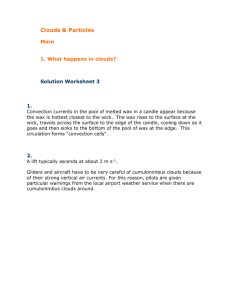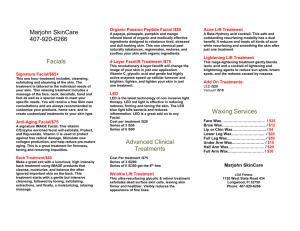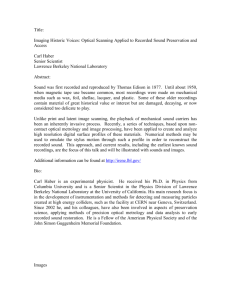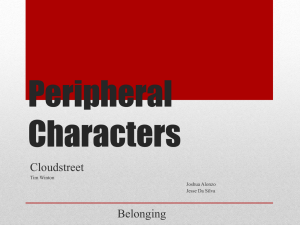INSTRUCTOR NOTES
advertisement
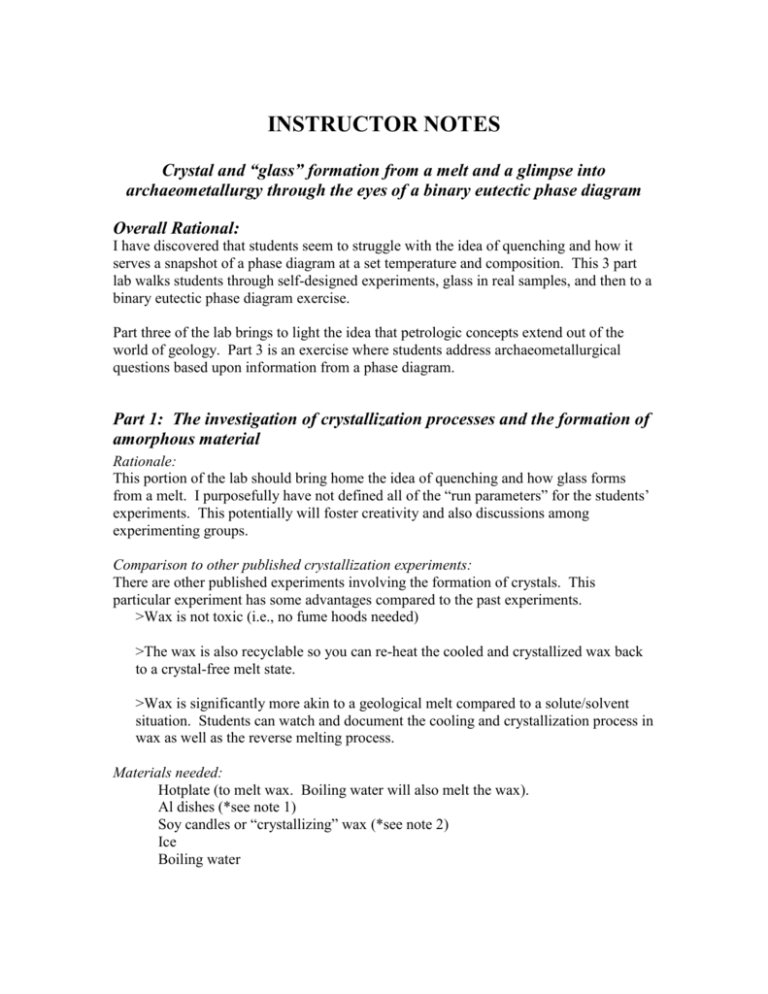
INSTRUCTOR NOTES Crystal and “glass” formation from a melt and a glimpse into archaeometallurgy through the eyes of a binary eutectic phase diagram Overall Rational: I have discovered that students seem to struggle with the idea of quenching and how it serves a snapshot of a phase diagram at a set temperature and composition. This 3 part lab walks students through self-designed experiments, glass in real samples, and then to a binary eutectic phase diagram exercise. Part three of the lab brings to light the idea that petrologic concepts extend out of the world of geology. Part 3 is an exercise where students address archaeometallurgical questions based upon information from a phase diagram. Part 1: The investigation of crystallization processes and the formation of amorphous material Rationale: This portion of the lab should bring home the idea of quenching and how glass forms from a melt. I purposefully have not defined all of the “run parameters” for the students’ experiments. This potentially will foster creativity and also discussions among experimenting groups. Comparison to other published crystallization experiments: There are other published experiments involving the formation of crystals. This particular experiment has some advantages compared to the past experiments. >Wax is not toxic (i.e., no fume hoods needed) >The wax is also recyclable so you can re-heat the cooled and crystallized wax back to a crystal-free melt state. >Wax is significantly more akin to a geological melt compared to a solute/solvent situation. Students can watch and document the cooling and crystallization process in wax as well as the reverse melting process. Materials needed: Hotplate (to melt wax. Boiling water will also melt the wax). Al dishes (*see note 1) Soy candles or “crystallizing” wax (*see note 2) Ice Boiling water Note 1: Al-dishes. These small dishes are often used for mixing epoxy or for oven drying samples. They are a convenient size for melting small amounts of wax. Students must be careful since do get hot and they are a little floppy. Glass beakers can be used instead, though they are harder to clean. Multiple layers of aluminum foil in a bowl shape also work well. Ideal containers for the wax are re-heatable which helps with the consolidation of wax during the experiment or cleanup. Note 2—Wax--Where to obtain the wax: --Astorlite: This is a product made by the Honeywell Corp. >Information on the material is available at http://www.astorlite.com/. >You can use any of the following types: Q, G, PQ, or F. >You can obtain 1 lb. samples of these wax pellets by clicking “sample requests” at the top of the web page. You will be charged for shipping only. >The wax pellets are colorless, if you would prefer to have some color, you can order colored wax pellets from the same company that will send you the samples. (The color pellets cost less than $1 each and it doesn’t take much colorant to tint the wax) >Do not heat the wax above 200oF. At high temperatures, the organic molecules break down and the crystallization will no longer take place. --Target: In the candle section, they carry a small selection of crystalline soy candles. >Be warned that the interior of these candles is non-crystalline wax. >This wax is scented, so, some students may have an adverse reaction to the perfumes in the wax. --Other discount stores: >Crystalline candles can sometimes be purchased from stores like Tuesday Morning, TJ Max, or Marshals. --Crystallizing Wax Kit: by Yaley Enterprises (Candle Crafting) Kit #112111 http://www.yaley.com/ 1-800-959-2539 --7664 Avianca Drive, Redding, CA, 96002) >This “kit” contains a 1 lb bag of white wax pellets. >You can also purchase this kit at craft stores like Hobby Lobby, Michaels, and JoAnn Fabrics. Part 2: Glass as a geological material Rationale: This portion of the lab reminds the students about the presence of glass in geological materials as well as how to identify it in thin section and hand sample. If you have trouble finding good thin sections containing glass, students can talk about how they know when they are looking at the thin section glass and not their sample. Part 3: Crystallization and quenching processes and binary phase diagram information for slag Rationale: This portion of the lab ties together quenching with phase diagrams. It also is the portion of the lab which gets students thinking outside of the geological box. Archaeometallurgy is an interesting field that spans the disciplines of material science, archaeology, history of technology, and geology. Instructor Notes: This worksheet assumes that the student has a basic understanding and familiarity with binary eutectic diagrams. Slag background: Slag is a waste product formed when a natural ore is smelted to create a pure metal. In a smelting process, a crushed mixture of ore and flux (e.g. cassiterite and calcite respectively) are added to a highly reducing, high-temperature (<1800°C) furnace. If the smelting reaction is successful, there is a separation of phases due to density and the heavier, refined metal will sink to the bottom of the reaction vessel. The remaining "float" material forms slag (fig. 1). Figure 1. A simplified view of a smelting process, wherein an ore and a flux are added to a furnace. After the smelting process is over, there is a separation of phases into metal and slag. After smelting, the metal or bloom is poured into ingots and the slag is recycled in a subsequent smelting process or it is dumped. Slag has also been incorporated into highway and road fill, used as a soil additive, or used as building material.


